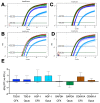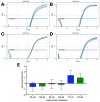FlashPCR: Revolutionising qPCR by Accelerating Amplification through Low ∆T Protocols
- PMID: 38474020
- PMCID: PMC10932470
- DOI: 10.3390/ijms25052773
FlashPCR: Revolutionising qPCR by Accelerating Amplification through Low ∆T Protocols
Abstract
Versatility, sensitivity, and accuracy have made the real-time polymerase chain reaction (qPCR) a crucial tool for research, as well as diagnostic applications. However, for point-of-care (PoC) use, traditional qPCR faces two main challenges: long run times mean results are not available for half an hour or more, and the requisite high-temperature denaturation requires more robust and power-demanding instrumentation. This study addresses both issues and revises primer and probe designs, modified buffers, and low ∆T protocols which, together, speed up qPCR on conventional qPCR instruments and will allow for the development of robust, point-of-care devices. Our approach, called "FlashPCR", uses a protocol involving a 15-second denaturation at 79 °C, followed by repeated cycling for 1 s at 79 °C and 71 °C, together with high Tm primers and specific but simple buffers. It also allows for efficient reverse transcription as part of a one-step RT-qPCR protocol, making it universally applicable for both rapid research and diagnostic applications.
Keywords: COVID-19; molecular diagnostics; point of care; qPCR; reverse transcription.
Conflict of interest statement
Author G.L.S. owns his consulting business Shipley Consulting. G.L.S. and the remaining authors declare that the research was conducted in the absence of any commercial or financial relationships that could be construed as potential conflicts of interest. The funders had no role in the design of the study; in the collection, analyses, or interpretation of data; in the writing of the manuscript; or in the decision to publish the results.
Figures






Similar articles
-
RT-qPCR Detection of SARS-CoV-2: No Need for a Dedicated Reverse Transcription Step.Int J Mol Sci. 2022 Jan 24;23(3):1303. doi: 10.3390/ijms23031303. Int J Mol Sci. 2022. PMID: 35163227 Free PMC article.
-
Development of a Novel RT-qPCR Detecting Method of Covert Mortality Nodavirus (CMNV) for the National Proficiency Test in Molecular Detection.Viruses. 2022 Jul 5;14(7):1475. doi: 10.3390/v14071475. Viruses. 2022. PMID: 35891455 Free PMC article.
-
Rapid and sensitive detection of potato virus Y by isothermal reverse transcription-recombinase polymerase amplification assay in potato.Mol Cell Probes. 2020 Apr;50:101505. doi: 10.1016/j.mcp.2019.101505. Epub 2020 Jan 2. Mol Cell Probes. 2020. PMID: 31904418
-
RT-qPCR with chimeric dU stem-loop primer is efficient for the detection of bacterial small RNAs.Appl Microbiol Biotechnol. 2017 Jun;101(11):4561-4568. doi: 10.1007/s00253-017-8181-0. Epub 2017 Mar 17. Appl Microbiol Biotechnol. 2017. PMID: 28314872
-
Tutorial: Guidelines for Single-Cell RT-qPCR.Cells. 2021 Sep 30;10(10):2607. doi: 10.3390/cells10102607. Cells. 2021. PMID: 34685587 Free PMC article. Review.
Cited by
-
Rapid Molecular Diagnostics of Pneumonia Caused by Gram-Negative Bacteria: A Clinician's Review.Antibiotics (Basel). 2024 Aug 25;13(9):805. doi: 10.3390/antibiotics13090805. Antibiotics (Basel). 2024. PMID: 39334980 Free PMC article. Review.
References
-
- Higuchi R., Fockler C., Dollinger G., Watson R. Kinetic PCR analysis: Real-time monitoring of DNA amplification reactions. Bio/Technology. 1993;11:1026–1030. - PubMed
-
- Lopez M.M., Llop P., Olmos A., Marco-Noales E., Cambra M., Bertolini E. Are molecular tools solving the challenges posed by detection of plant pathogenic bacteria and viruses? Curr. Issues Mol. Biol. 2009;11:13–46. - PubMed
MeSH terms
LinkOut - more resources
Full Text Sources

